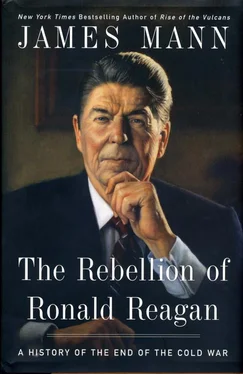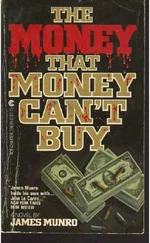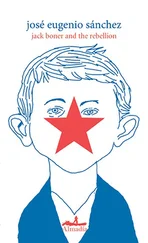On May 27, 1988, two days after Reagan had flown to Helsinki to prepare for the Moscow summit, the Senate ratified the INF treaty by a vote of 93 to 5. It was the first arms-control treaty between the United States and the Soviet Union that had won Senate approval since 1972. And it was the first time since the beginning of the Cold War that the two governments had signed a genuine disarmament treaty—not merely reducing numbers of weapons, but eliminating them and agreeing to enforce the ban.
-8-
THE NOT-SO-EVIL EMPIRE
When Ronald Reagan departed for the Soviet Union in May 1988, he had scarcely traveled outside the United States for a year. Since his speech at the Berlin Wall the previous June, Reagan had ventured beyond America’s borders only for a one-day stopover in Mexico and an obligatory visit to a NATO summit in Brussels. He and his advisers were long past the point of trying to conceal the president’s chronic problems with sleep and jet lag. To prepare for Moscow, Reagan found it necessary to stop first for four nights of sleep and relaxation in Helsinki. While there, the president and his wife took turns having a massage by a Finnish masseuse George Shultz had recommended to them. As usual, they ventured forth rarely into the city they were visiting. Instead, they watched tapes specially brought to them of American network news shows. They retired early. 1
As the president approached another summit, his old friends in the conservative movement shuddered. In a pair of columns, George Will acidly portrayed the president as having betrayed the cause of anticommunism. “Four years ago, many people considered Reagan a keeper of the Cold War flame. Time flies,” Will wrote. “For conservatives, Ronald Reagan’s foreign policy has produced much surprise but little delight. His fourth and, one prays, final summit is a suitable occasion for conservatives to look back with bewilderment and ahead with trepidation.” 2
The interlude in Helsinki gave the president a chance to start coping with the surveillance issues he would soon confront in Moscow. Reagan had never spent a night behind the Iron Curtain. His firsthand experience inside a Communist country had been confined to his fleeting afternoon drive into East Berlin a decade earlier and his 1984 visit to China (which Reagan had labeled a “so-called communist” country). In Helsinki, where American and Finnish officials were constantly mindful of the possibility of KGB spying, Reagan was obliged to converse with his advisers inside a secure room, “the box,” in the American embassy.
One subject they discussed was Reagan’s idea for a dramatic public demonstration of concern for Soviet Jews upon his arrival in Moscow. The wife of a Russian pianist who had emigrated to the United States let Nancy Reagan know about another Russian Jewish couple, Tatyana and Yuri Ziman, who were still living in Moscow and had been waiting for years for exit visas. Reagan’s original plan was to make the Zimans’ apartment his very first stop after arrival in the Soviet Union; the idea was for the president to visit the Jewish family even before his arrival ceremonies in the Kremlin. Gorbachev was furious when he learned what the Reagans wanted to do, according to U.S. Ambassador Jack Matlock. In Moscow, Deputy Foreign Minister Alexander Bessmertnykh was ordered to tell Matlock that if Reagan were to carry through on these plans, they would embarrass Gorbachev and could have disastrous consequences. Next, Bessmertnykh flew to Helsinki to protest directly to Assistant Secretary of State Rozanne Ridgway and the presidential entourage. The Zimans might never leave the Soviet Union if Reagan visited them, Bessmertnykh warned. If he didn’t, the couple might be allowed to go soon.
It was the first contretemps of the summit, which hadn’t even begun. Matlock rushed to Helsinki to confer with Powell and Chief of Staff Howard Baker. All of them spoke with the Reagans. The president decided to drop the Ziman event from his itinerary, and at the same time, to take Bessmertnykh’s words as a promise to let the couple leave the country. “It was kind of ambiguous, and we said, ‘We’re interpreting what you said as a commitment,’” recalled Shultz. The Zimans were allowed to depart a few months later (but only after Reagan, back in Washington, called the Soviet ambassador to inquire again about their exit visas). 3
On Sunday, May 29, 1988, the president left Helsinki for Moscow. Peering out of the window of Air Force One onto Soviet territory, Reagan murmured to Powell, “Look, there’s almost no traffic.” He was accustomed to the cars, houses, and opulence of the United States—the material well-being he had dreamed of putting on display to Gorbachev during his visit to the United States. Despite Reagan’s three previous meetings with the Soviet leader, the symbolism of the president’s arrival in Moscow was lost on no one, including the Reagans themselves. Over the previous quarter century, Reagan had emerged as the most renowned anti-Communist in American political life; now he was arriving at the headquarters of the Communist movement. “If someone had told me when Ronnie and I were first married that we would eventually travel to Moscow as president and first lady, and would be the honored guests of the Soviet leadership, I would have suggested that he get his head examined,” Nancy Reagan admitted. 4
Having canceled their visit to the Jewish family, the Reagans instead went directly from the airport to the Kremlin. Inside, they had to walk up a long staircase, covered by a red carpet. Mikhail and Raisa Gorbachev stood at the top, waiting for them. Onlookers said Reagan seemed dazed and overwhelmed by the moment. He started up the steps, stopped, and then took his wife’s hand before resuming the climb. 5
After the arrival ceremonies, the president immediately sat down with Gorbachev in St. Catherine’s Hall at the Kremlin for their first talk. At each of their summits, the two men held a couple of meetings that were labeled as “one-on-one” sessions, in which Reagan and Gorbachev spoke to each other outside the presence of top-level aides, such as Shultz and Eduard Shevardnadze, the Soviet foreign minister. (In fact, the two men were not completely alone. Each brought a translator and two other officials to take notes.)
The texture of these one-on-one meetings was qualitatively different from the larger meetings in which Reagan and Gorbachev were joined by their advisers. They were more informal and unstructured, enabling the two leaders to demonstrate their priorities and personalities. The two leaders left the detailed policy discussion for the larger meetings.
It was during the first one-on-one session in Moscow that Reagan engaged in a bold but questionable endeavor well beyond his mandate as president of the United States. According to the transcripts of their meeting, which have now been declassified, Reagan secretly attempted to persuade Gorbachev of the existence of God.
The meeting opened with pleasantries. Both men agreed that they and their countries had come a long way since their first summit in Geneva three years earlier. Gorbachev then immediately turned to a surprise for which Reagan was not prepared: he read aloud and handed the president a written statement he wanted the two governments to sign during the summit that would commit the United States and the Soviet Union to “peaceful coexistence.” Reagan said vaguely that he liked the idea and would talk it over with his advisers; he handed the piece of paper over to one of his notetakers, Thomas Simons. Gorbachev’s proposal would become the subject of considerable acrimony over the following days.
The two men next revived their running debate about human rights. Reagan handed Gorbachev a list of names of Soviet citizens he believed were victims of repression in one fashion or another, starting with the Zimans and their eagerness to leave the country. As in the past, Gorbachev countered by arguing that America could be criticized for its own human rights abuses too.
Читать дальше












